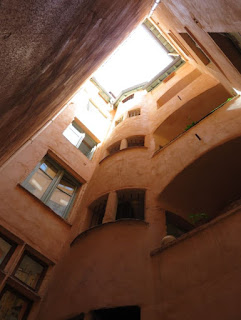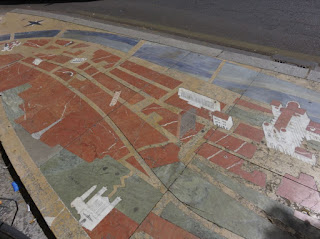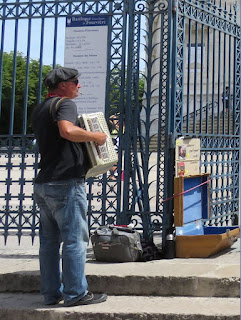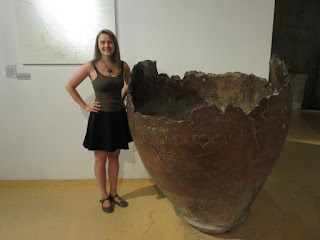This morning we have decided to walk the traboules of Saint George, so to gain strength for the excursion, we first head to Pâtisserie Perroudon in Saint Georges for our ritual coffee and croissant. On the way, we pass the Saint Jean Cathedral, and the Saint Jean Bio market in Place Commette, next to the remains of the 9th Century church Refectory. Betty salivates over the fresh fruit, but we can't let healthy options stop us from getting to our morning pastries! ;)
We sit down on the shady sidewalk patio of Pâtisserie Perroudon, sharing very delicious almond croissant and pain au raisin with a very courageous songbird. After confirming that it was safe to eat the crumbs I offered him on my outstretched palm, he decides it's also ok to eat my pastry right out of my mouth, and dive-bombs my face as I sit mid-bite. lol. My only quibble with this establishment is with the tiny size of the coffees... I believe I ordered a "large" café au lait... ;)
As we check the news, we are happy to have left Paris yesterday, as apparently, today Paris is aflame in Uber-car protests! Sitting in this 16th century neighborhood, we feel very far from the modern world. After our traboules, we will head up the hill to the Fourvière to see the Basilica and the ancient ruins of two Roman ampitheatres. All together, it will be at least 5.5km, not counting five floors of museum wandering. For the traboules of Saint George, the only map I could find was in the most excellent and useful Le Magazine du Vieux Lyon, so I'll include a version of it here (sorry about the quality of my reproduction). If you find an online version, please let me know.
In the following centuries, the areas closer to the river gained more and more religious importance, under the lordships of the religious orders of St-Jean, St-George, and St-Paul. Between the 14th and 16th centuries, Lyon became emancipated from the church, and then faced a period of floods and plagues. Due to these difficulties, Lyon was granted special trading rights, to sell goods without taxes at certain times of year. These rights caused Lyon to rebound as a trading port, and its silks and metal products became well-sought throughout the Renaissance period. The style of the buildings and streets of Vieux Lyon still reflect this period of prosperity.
The production of silks also helped create a very unique feature of Lyon: the Traboules. Traboules are old secret passageways through the city. Historically, they were mainly used to get water from the river and to transport Lyon's famous silks through town without them getting rained on. The traboules are still used today by shopkeepers to transport various goods between the streets... and of course by curious tourists. Today, most of the traboules also serve as entryways to residential buildings, which is why many are locked and marked "private."
My gite, the Lyon Renaissance - Coté Cour, faces the Mairie and is kitty-corner to a famous traboule, Le Cour des Loges, a five-star luxury hotel and restaurant complex which is an amalgamation of four buildings dating to the Renaissance, including a former Jesuit College. There are many spiral staircases and a labyrinth of passageways inside, linking all the buildings together. The last time I stayed at the Lyon Renaissance, the Propriétaire of our gites, Patrick, had told us the secret to visiting the Cour des Loges on a budget: go into the lounge to have a glass of wine, and you will gain access to the amazing multi-level courtyard traboule. While my gite is not officially a traboule, the blue discreet doorway into the 17th century building and the four floors of narrow spiral staircase up to the suite might convince you otherwise. ;) Looking down out my window, I get a great view of the courtyard below (that's the Mairie with the flags, which includes the Marriage Hall). Looking to the South, I can see along Rue du Boeuf towards Betty's gite.
The gite Betty is renting is actually a very famous traboule: the Tour Rose at 16 Rue du Boeuf. (Not to be confused with the hotel-restaurant called the Tour Rose at 22 Rue du Boeuf). The gite itself is called Lyon Renaissance - Coté Jardin. I stayed in this gite before, several years ago, and found it absolutely delightful, and impeccably decorated (sorry, my photo does not do it justice--check out their website for better photos). I'm thrilled to give Betty the same opportunity to dwell in such a famous piece of history. The building, including the tower, used to be a 16-17th century mansion called Maison du Crible, which has now been converted into a gite and several private residences. Walking in through the huge studded green door, which is crowned with a bas-relief of the Christian Nativity scene, one comes face to face with the French Orthodox Chapel of Saint Jean le Théologien, which still holds liturgies on the second and fourth Sunday of the month at 9:30am. Turning around towards the entrance gives you a spectacular view of the five-story tower. The gite and the hanging gardens are above the church on the second-level courtyard, above the church. Naturally, many tour groups wander into the lower courtyard during the day. Fortunately, for privacy's sake, the residents lock the door in the evening, restricting access to those with a special passcode or key.
To tour the traboules as a tourist, you need to know which door(s) lead to a traboule, then find the right button to press to unlock the door. Usually, it is the larger plain silver button at the bottom of the numerical keypad next to the door. Sometimes, the button is red. Occasionally, the entrance button is marked "service." Don't be afraid to push this to gain entrance. You will not disturb a person; it merely unlocks the door. Very occasionally, you will need to press a different button, like "P" (for "Porte") or "O" (for "Ouvert"). In those cases, it's trial and error. Usually, the correct button will be more worn than the other buttons on the keypad. Once inside, there is often a light switch located on the wall somewhere near the door. Sometimes the light switch itself is lit up with a little LED, which can really help to locate it in some of the darker traboules... Or to locate the door unlock button from the inside, which is often on the door itself, near the handle.
We head through a long hallway to take a look at the courtyard at #6 RSG, then take the steep spiral staircase up four floors. I hold onto the stone stairs themselves as handholds. At the top of the stone stairs, there are another set of stairs we could not see from below. They take us up another few flights and give a nice view of the hills behind Vieux Lyon. It's an exciting first traboule!
#7 RSJ also offers a nice courtyard, but not the twisted passageways of #6. We head into #11 RSG, do the 5 floors of spiral staircase up the courtyard, and exit #26 RDD, then head back in #32 RDD.
Next, we walk down RSJ to where it meets the Montée du Gourgillon (MDG), which is called Place de la Trinité. Here there is a very famous Café Du Soleil, with its Guignol theatre and excellent quenelles. Thankfully, the red door of #2 is near the bottom of the very steep MDG (see right side of second photo).
#2 MDG is similar to #6 RSJ: we take the hallway to the ground-level courtyard, then we climb up the spiral staircase five floors, cut across through another courtyard to a small yellow archway on the other side, which leads up another spiral staircase to a rooftop garden with a view of Cathedral Saint Jean and Croix-Rousse. There is one more worn-down straight staircase from the rooftop garden, so we take it up, but it dead-ends at someone's apartment. We take a moment to absorb the necessary fitness level of the person who lives here.
We take some time to admire silk stores and a mosaic of Lyon at Place Saint Georges on our way to #5 Rue Jean Carries (RJC). Betty's iconic Tour Rose features prominently in the mosaic. #5 RJC appears to be locked, so we continue on Rue Saint Jean, past the Cathedral to Rue de la Bombarde to take in Place de la Basoche and its iconic Lion. We try #14 Rue de la Bombarde, which should take us through several passages anad courtyards to Rue du Boeuf, but it is also locked. It could simply be the case that many traboules are only open in the morning, and now it is too close to noon, but since we have completed all of the Saint George Traboules, we take it as a sign that it's time to stop for the day, and decide to start here and do the Saint Jean traboules tomorrow morning.
We stop at the Boulangerie du Palais and purchase an eggplant sandwich and a tuna-egg sandwich, stop by my gite to grab the rest of the bottle of wine I had from last night, and return to Betty's gite to create a lovely lunch on the patio.
After lunch, the heat is getting worse, and so to conserve our strength, we decide to walk back to the Metro station at Place Saint Georges, and ride the furnicular up to the top of the Fourvière hill. The furnicular sounds like a modern invention, but actually, it is fairly old. In Lyon, five furniculars were built between 1862 and 1900, but today only two are left: those leaving from this station and heading up the hill behind Vieux Lyon. In the tunnel on the way up, statues in alcoves are lit by mini-spotlights, giving an eerie feeling.
At the top, we are let off very close to the Basilica. At the gate, an accordion player in a beret plays folk tunes. Because France. Beside the Basilica, there is the Chapelle Saint Thomas and The Chapelle de la Vierge, as well as a small museum.
We don't go inside the Basilica, but the view from the Basilica is impressive: we can see almost all of Lyon! We realize we are looking down the Cours Lafayette, where we had walked from the Lyon Part-Dieu train station the day we arrived. The angular 200m Tour Incity and the 165m Tour Part-Dieu, a.k.a. The Radisson Hotel, a.k.a. "The Crayon," stand in stark relief against the rest of the city.
(click on the pano for full size)
We walk the Stations of the Cross, reading each one aloud. There is also a statue of Pope John Paul II, and a very cool 3D model of Lyon made of bronze. For those interested in a self-tour, there is a downloadable audio guide at www.fourviere.org/telecharger-laudio-guide
We don't bother walking over to the 10m mini-Eiffel Tower, which was once a restaurant and now serves as a TV tower. Instead, we head Southwest towards the old Roman Ruins. There are two amphitheatres here, the larger Grand Théâtre and the smaller Odéon, which are free and open to the public. As we approach, we can see the tents ready for Nuits de la Fourvière, an annual cultural festival that brings modern musicians, dancers, theatre, and other performances to the old theatres. I had been to a circus performance here in the past, which was really really neat, but this year, there wasn't anything appealing playing in the few days we are here in Lyon.
The Grand Théâtre (above) is the oldest theatre in Gaule, built around 15 BCE, in the reign of Augustus Caesar. Its original seating capacity was 11,000, because it used to have a second tier of seats. Today, it can accommodate less than half that amount. The smaller Odéon theatre (below) was built later, in the 1st and 2nd Centuries CE, and also had several tiers of seats.
Since this site was expanded in Hadrian's reign expanded on this site, we pretend that I am walking on Hadrian's Wall (what do you mean, "wrong country"?)
After exploring the ruins, we notice the Gallo-Roman Museum, perched discreetly on the hill beside the Grand Théâtre. The odd, port-hole like windows in the hill are view-ports from the inside of the museum. We decide to go check it out. Not only does it seem like a good respite from the heat, but I have also never been there before, and perhaps most importantly, admission is free on Thursdays! :D
Some other of my favorites were this lion head I saw on a marble bath, some very early Roman bronze coins, the head of a 3m tall statue of Jupiter (they only found the head), and a tile mosaic of horse and chariot races. One particular display really caught my eye: a set of bronze dodecahedrons. Sixty of these were found in numerous places on Celtic land in France, and no-one knows what they represent or what they were used for.
I take a look out the viewports. They have recreated scale models of what the theatres would have looked like in their day, including a mechanized working model of the pulley system that was originally used for the stage curtains.
On the bottom floor of the museum is an interesting exhibit called "Sticks and Stones," about a piece of mahogany wood found in a river after laying there for 100 years. The artist then duplicated it in various mediums, creating each subsequent copy from the previous copy.
After finishing with the museum, we hike back to the Basilica, and take the Parc des Hauteurs down the side of the hill. Heading South takes us over to the Rose Garden.
Heading North takes us down towards Vieux Lyon. Metal roses are embedded into the cobblestone pathway, for those who want to say the rosary on their way up to the Basilica. The path down is beautiful and shady, with several courtyards of flowers, fountains, and benches on which to rest.
We follow signs past the 16th Century Maison de Pauline Marie Jaricot, and exit onto Montée Saint Barthélémy through a small chapel that Pauline erected and dedicated to Sainte Philomène in 1839. When the road meets the Montée des Chazeaux, we turn right, fill our depleted water bottles and take the 228 stairs down to Rue du Boeuf.
Being barely 6pm, the restaurant is completely empty, and the staff are just starting to set up for the supper service. We tell the server that we know it is way too early for supper, but we are Canadians and used to eating ridiculously early. That gets us a laugh and a table by the door, where we can enjoy a cool breeze. We go all out with Kir du Maison (kir with dates!), hummous, couscous, tagines, and finishing with Moroccan mint tea and assorted sweets. Working our way through a bottle of Cote du Rhone, we can't imagine ourselves pulling off the cobblestoned streets in the heels we see passing by. After dinner, we retire early and try to catch up on our sleep.
































































































No comments:
Post a Comment